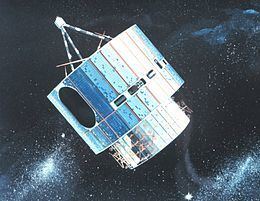COSPAR ID 1977-048A Mission duration 24 years Period 24 hours Launch mass 295 kg Rocket Delta 2000 | SATCAT no. 10061 Spacecraft type SMS Launch mass 295 kg Launch date 16 June 1977 | |
 | ||
Similar GOES 3, GOES 1, GOES 4, GOES 5, GOES 7 | ||
GOES 2, known as GOES-B before becoming operational, was a geostationary weather satellite which was operated by the United States National Oceanic and Atmospheric Administration as part of the Geostationary Operational Environmental Satellite system. GOES 2 was built by Ford Aerospace, and was based on the satellite bus developed for the Synchronous Meteorological Satellite programme. At launch it had a mass of 295 kilograms (650 lb). It was positioned in geostationary orbit, from where it was used for weather forecasting in the United States. Following its retirement as a weather satellite, it was used as a communications satellite until its final decommissioning in 2001.
GOES-B was launched using a Delta 2914 carrier rocket flying from Launch Complex 17B at the Cape Canaveral Air Force Station. The launch occurred at 10:51:00 GMT on 16 June 1977. The launch successfully placed GOES-B into a geosynchronous transfer orbit, from which it raised itself to geostationary orbit by means of an onboard SVM-5 apogee motor. Its insertion into geosynchronous orbit occurred at 03:26 GMT on 17 June.
Following on-orbit testing, GOES-B was redesignated GOES 2, and replaced SMS-1 at a longitude of 60 degrees west. It was operated as a weather satellite at several different positions until 1993, and was then placed into storage. It was reactivated as a communications satellite in 1995, and moved to 177° West. It was used by Peacesat to provide communications services to islands in the Pacific Ocean, a role in which it was replaced by GOES 7 in 1999, and by the US National Science Foundation for communications with the Amundsen-Scott South Pole Station. On 5 May 2001, it was retired to a graveyard orbit. At 21:08 GMT, two hours after the last manoeuvre to remove it from geosynchronous orbit, GOES 2 was commanded to deactivate its communications system, preventing future ground commands being sent to it.
